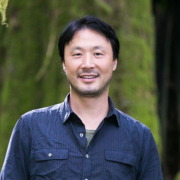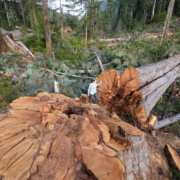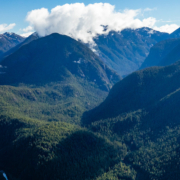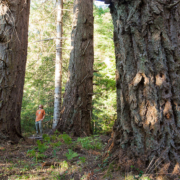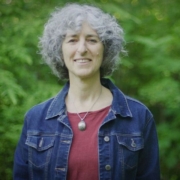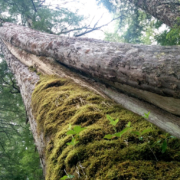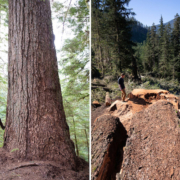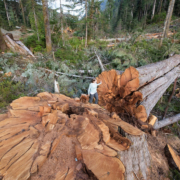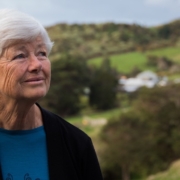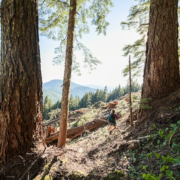AFA’s Executive Director Ken Wu steps down to start new organization, the Endangered Ecosystems Alliance, while remaining on AFA’s Board
Victoria, BC – The Ancient Forest Alliance’s co-founder, Ken Wu, has announced his departure from his position as the organization’s Executive Director of eight years, since co-founding the group in early 2010. Wu is currently establishing a new national organization, the Endangered Ecosystems Alliance, that will be focused on promoting “ecosystem literacy” and the science-based protection of all native ecosystems in Canada.
Wu co-founded the Ancient Forest Alliance with TJ Watt in 2010 after working for a decade as the Executive Director and Campaign Director of the Wilderness Committee’s Victoria chapter. Watt, the AFA’s Campaigner and Photographer, whose photos of BC’s biggest trees and stumps have graced news and social media sites around the world since the organization’s inception, will join Campaigner Andrea Inness and Administrative Director Joan Varley to form an Executive Team that will replace the Executive Director and lead the effective management of the organization. Wu will remain on the Board of Directors of the Ancient Forest Alliance and will continue to assist the organization in an advisory, training, and fundraising capacity.
“It’s time for me to move on from running the day to day operations of the Ancient Forest Alliance as its Executive Director and to commence with my new organization, the Endangered Ecosystems Alliance, which I’ve been thinking about for several years now,” stated Wu. “For the past few years, I’ve had to split my time between Victoria, where I’ve lived for the previous 20 years running environmental groups including the Ancient Forest Alliance, and Montreal, where my family is. It’s become unfeasible to spend so much time in BC away from my 2-year-old daughter in particular.”
“I’m very excited to start a new national organization that will work to protect endangered ecosystems across the country, based on science and traditional ecological knowledge, and that incorporates the many insights on environmental campaigning that I’ve gained over the span of 27 years at the Ancient Forest Alliance and other environmental organizations. While I love old-growth temperate rainforests and am fully dedicated to their protection, I’ve always been a fanatic for the diversity of native ecosystems in Canada and around the world. For years, I’ve yearned to further explore and help protect the prairie grasslands and badlands, the dry Ponderosa pine forests, grasslands and “pocket desert” of the BC Interior, the diverse Carolinian deciduous forests of southern Ontario, the spectacular, rich marine ecosystems of both the East and West Coast, and the overlooked and neglected freshwater ecosystems of Canada.”
“I will continue to advise and assist the Ancient Forest Alliance in their work and will partner with the AFA through the Endangered Ecosystems Alliance on campaigns to protect old-growth temperate rainforests, which has been an enduring passion of mine since I was a child.”
“I’m proud of the work the Ancient Forest Alliance has done over the years, protecting the Avatar Grove, building alliances with First Nations, environmental groups, and non-traditional allies including businesses, Chambers of Commerce, unions, and forestry workers, and changing the narrative in BC forestry politics to show that protecting old-growth forests is a net benefit for the economy.”
“I feel confident leaving the AFA, given the organization now has long-term, dedicated, and highly skilled staff; is financially viable having grown almost ten-fold in annual revenues since its inception; and has an extensive, dedicated base of supporters that will always keep it afloat. At the same time, the organization still is modest in size and still needs to grow more in order to hire additional staff and increase its capacity to ensure the protection of BC’s old-growth forests. To this end, I will continue to assist the AFA everywhere I can while building my new organization.”
Since its founding, the Ancient Forest Alliance has grown from a small organization with just two staff, 300 donors and an annual revenue of $60,000, to nine primary staff, over 20,000 donors, and projected revenues of $600,000 this year – the vast majority of which comes from individual donors within British Columbia.
The Ancient Forest Alliance is best known for its successful campaign with the Port Renfrew Chamber of Commerce to protect the Avatar Grove old-growth forest and for building a high-quality boardwalk in the grove to protect the forest understory, enhance visitor safety and access, and to support the local eco-tourism economy. Since then, Port Renfrew has been dubbed the “Tall Trees Capital of Canada” and has experienced a massive surge in economic activity due to the interest in old-growth tourism around the town. The AFA’s campaign to vastly expand the ancient forest movement to include “non-traditional allies” including Chambers of Commerce (resulting in a resolution by the BC Chamber of Commerce in 2016 calling on the BC government to expand old-growth protections in the province to support the economy); with forestry workers including the Public and Private Workers of Canada (PPWC) (who passed a resolution calling for an end to old-growth logging on Vancouver Island in 2017), and with local governments (including the Union of BC Municipalities which called for an end to old-growth logging on Vancouver Island in 2016), has helped to change the narrative in the province that protecting old-growth forests hampers the economy and jobs – instead, showing the opposite to be true, that protecting old-growth forests creates significant revenues and employment opportunities in local communities.
The AFA has also helped to raise the profile of endangered old-growth forests in the province, partly through identifying and nick-naming ancient groves and trees, including “Big Lonely Doug,” Canada’s 2ndlargest Douglas-fir tree near Port Renfrew, and by developing a viral campaign earlier this year against the logging of old-growth stands in the Nahmint Valley near Port Alberni, where Canada’s 9thwidest Douglas-fir was cut down. The organization’s campaigns have exerted significant pressure on both the previous BC Liberal government, which backed down from opening up Old-Growth Management Areas for logging and from expanding Tree Farm Licences in the BC Interior due to pressure from the AFA and its allies, and now the new NDP government, which is feeling the heat in particular over old-growth logging by its own logging agency, BC Timber Sales, due to the AFA’s campaign in the Nahmint Valley.
More Background Info
Old-growth forests in BC are home to unique and endangered species that can only live in old-growth forests, are vital pillars of BC’s multi-billion dollar tourism industry, store vast amounts of atmospheric carbon, provide clean water for communities and wild fisheries, and are vital parts of many First Nations cultures. The 50- to 100-year-old rotation age for logging in BC ensures that old-growth forests will never return after they are cut; therefore, logging old-growth forests is a non-renewable activity. Large-scale industrial logging is the norm over vast regions of British Columbia, making it the last western jurisdiction where old-growth logging is still a dominant economic activity. On Vancouver Island, already about 80% of the original, productive old-growth forests have been logged, including well over 90% of the valley bottoms where the largest trees grow. Only about 8% of the original, productive old-growth forests are protected in parks and Old-Growth Management Areas on Vancouver Island.
The Ancient Forest Alliance is pushing for the BC government to enact new legislation to protect BC’s remaining old-growth forests based on science, while also calling on the BC government to support First Nations land use planning with conservation financing dollars to support the sustainable economic development and diversification of the communities as old-growth forests are protected. In the meantime, immediate measures are needed to halt old-growth logging while land use plans are developed, including implementing moratoria in old-growth “hotspots” (i.e. more intact areas of greater conservation significance), effective legislation to protect the biggest trees with surrounding buffer zones as well as the grandest groves, upgrades to “non-legal” Old-Growth Management Areas into becoming legally-binding entities, and a halt to the BC government’s logging agency, BC Timber Sales, from issuing old-growth cutblocks. In addition, a BC land acquisition fund is needed to purchase and protect endangered ecosystems on private lands, including old-growth forests.
Wu’s new organization, the Endangered Ecosystems Alliance (EEA), will focus on lobbying the provinces and territories to adopt the federal 17% protection target by 2020 for Canada’s terrestrial and freshwater ecosystems, while ultimately pushing for federal and provincial endangered ecosystems legislation that requires protection targets be established based on the latest conservation biology science and Indigenous traditional ecological knowledge in all ecosystem types across the country. The organization will also focus on promoting “ecosystem literacy” to help expand awareness among Canadians about the biogeography, flora, fauna, and conservation status of ecosystems across the country, including where they live.
The Endangered Ecosystems Alliance’s first launch events will occur in Victoria on Sept. 17 (Alix Goolden Hall, 7-9pm), in Avatar Grove on Sept. 18 (meeting at the trailhead at 1pm and touring the grove until 4pm), and in Vancouver on Sept. 19 (Croatian Centre, 3250 Commercial Drive, 7-9pm), where guest speakers will include renowned conservation biologist Dr. Reed Noss, botanist Dr. Andy MacKinnon, conservationist Vicky Husband, forestry worker and union leader Arnold Bercov, and Ancient Forest Alliance campaigner Andrea Inness.
The EEA’s new website (still under development) can be seen at: www.EndangeredEcosystemsAlliance.org

